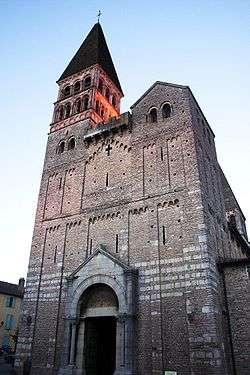Saint-Philibert de Tournus

Saint-Philibert de Tournus is a medieval church, the main surviving building of a former Benedictine abbey in Tournus, France. It is of national importance as an example of Romanesque architecture.
History
In 875 monks fleeing Viking raids on Noirmoutier came to Tournus with the relics of Saint Philibert.
The abbey was closed in the seventeenth century and St Philibert became a collegiate church. During the French Revolution it was secularised as a Temple of Reason. Subsquently, Roman Catholic worship resumed.
Architecture
The earliest buildings on the site are assumed to have been destroyed by a Hungarian invasion. Some sources suggest that construction of the present building began before 1000, although most of the construction is somewhat later. It is in the early First Romanesque style of Burgundy, which began to use further Romanesque and early Gothic styles during the beginning of the 11th century.
The church is set in a fortified enclosure, and defence was evidently a factor in the design of the building. The west front can be described as "lithic" in that it has heavy masonry walls and few windows.
Interior
The nave is roofed with barrel vaulting, supported on tall cylindrical columns
Conservation
In the nineteenth century the building was restored by Charles-Auguste Questel.
See also
Noirmoutier was the location of the first recorded Viking raid on continental Europe, when raiders attacked the monastery in 799.[1] Around 863 the monk Ermentarius wrote a history of the transfer of the monastery and the relics of Philibert of Jumièges.
References
- ↑ Sawyer, Peter. "The Viking Expansion." The Cambridge History of Scandinavia, Volume 1: Prehistory to 1520. 105.
External links
| Wikimedia Commons has media related to St Philibert, Tournus. |
- First Romanesque in France, Pictures of St. Philibert at Tournus and St. Martin at Chapaize
- Tournus page on the site Bourgogne Romane
Coordinates: 46°33′56.09″N 4°54′32.79″E / 46.5655806°N 4.9091083°E